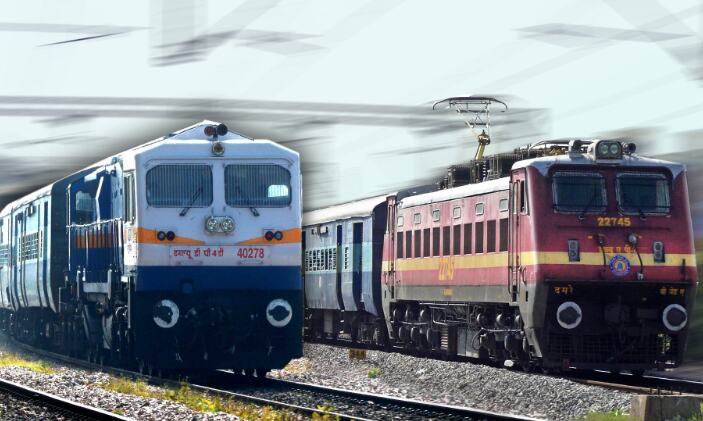Reimagining the 'nature' connect
Colonial-era Indian Railways has evolved a great deal alongside the New India — addressing its emergent needs through ‘greener routes’

The World Environment Day, 2021, pivots on a "REIMAGINE. RECREATE. RESTORE" approach towards ecosystems for protecting nature. Amidst a global rallying cry for everyone – from global governments to corporations and citizens – to do their part in healing our ailing planet, the leadership role of Indian Railways deserves analysis, comment and appreciation.
The launch of 'UN Decade on Ecosystem Restoration' states succinctly: "This is our moment. We cannot turn back time. But we can grow trees, green our cities, rewild our gardens, change our diets and clean up rivers and coasts. We are the generation that can make peace with nature. Let's get active, not anxious. Let's be bold, not timid. #GenerationRestoration".
The Hashtag is sure to stir up flurries of responses that choke up social media in this single-day celebration. Alongside, the 'on-ground' systemic initiatives in Indian Railways speak volumes with their silent yet unrelenting rollout of reforms over time. Indian Railways (IR) is working in mission mode to become the largest Green Railways in the world and is moving towards becoming a "net zero carbon emitter" before 2030. Railways is guided by a holistic vision of being an environment friendly, efficient, cost-effective, punctual and modern carrier of passengers as well as freight in order to serve the growing needs of New India. IR is looking at helping the environment with steps ranging from massive electrification, water & paper conservation, to saving animals from being injured on Railway tracks.
Railway Electrification, which is environment friendly and reduces pollution, has increased nearly 10 times since 2014. Capturing the economic benefits of electric traction in an accelerated manner, Railways has planned to electrify balance Broad Gauge (BG) routes by December 2023 to achieve 100 per cent electrification of BG routes. Head-On-Generation systems, Bio-Toilets and LED lights recreate the train itself into a travel mode that's kinder to the environment while maintaining comparable passenger comfort.
As India grows into a young demographic, there is an increasing need for goods' and services' consolidate. Rail tracks that criss-cross the nation via IR's Dedicated Freight Corridors are being developed as a low carbon green transportation network with a long-term low carbon roadmap, which will enable it to adopt more energy-efficient and carbon-friendly technologies, processes and practices. IR is implementing two Dedicated Freight Corridor projects viz. Eastern Corridor (EDFC) from Ludhiana to Dankuni (1,875 km) and Western Corridor (WDFC) from Dadri to Jawaharlal Nehru Port Trust (1,506 km). Sonnagar-Dankuni (538 km) portion of EDFC has been planned for execution on Public-Private Partnership (PPP) mode.
Pandemic-induced resets of industries and transportation have globally underscored supply chain impact on environments. IR's network and reach enabled movement of Freight, like Food Grains & Oxygen during the ongoing pandemic, even while being more environment friendly as compared to Road transport. During the period April 2021 to May 2021, the Indian Railways moved 73 Lakh tonnes of food grains and has run 241 loaded Oxygen express trains, moving 922 loaded tankers, thereby transporting 15,046 tonnes of oxygen to various part of the country. For bulk supplies of most distribution chains, railways remain the transport of choice and IR has demonstrated efficiencies in these linkages.
A railway isn't just tracks and trains, they say, and a station is where "the train meets the city". IR has made this meeting point much greener lately, with certifications to prove it. Green Certifications and implementation of Environment Management System: MoU signed between IR and Confederation of Indian Industry in July 2016 for facilitation of Green initiatives on IR. 39 Workshops, 7 Production Units, 8 Loco Sheds and one Stores depot have been 'GreenCo' certified. These include 2 Platinum, 15 Gold and 18 Silver ratings.
Green certification mainly covers assessment of parameters having a direct bearing on the environment, such as energy conservation measures, use of renewable energy, Green House Gas emission reduction, water conservation, waste management, material conservation, recycling etc. 19 Railway Stations have also achieved Green Certification including 3 Platinum, 6 Gold and 6 Silver ratings. 27 more Railway Buildings, Offices, Campuses and other establishments are also Green certified including 15 Platinum, 9 Gold and 2 Silver ratings. In addition, over 600 Railway Stations have been certified for implementation of the Environment Management System to ISO: 14001 in the last two years. A total of 718 stations have been identified for ISO: 14001 certification.
A lasting colonial image of the industrial revolution era was the steam locomotive, "belching smoke and awed by natives". Indian Railways have assimilated this heritage while consigning ancient locomotives to museums and building the network anew post-independence. British era railways split into Indian, Bangladesh, Sri Lankan and Pakistan rail networks over time and IR has evolved at a much faster pace, setting a greener tone through time. The scenic landscape of mountain railways, Konkan and other coasts, ports and container services together transform the palette to verdant shades, in an approach that matches global environmental objectives in lockstep with technology and compliances.
The writer is ED Heritage, Railway Board. Views expressed are personal



